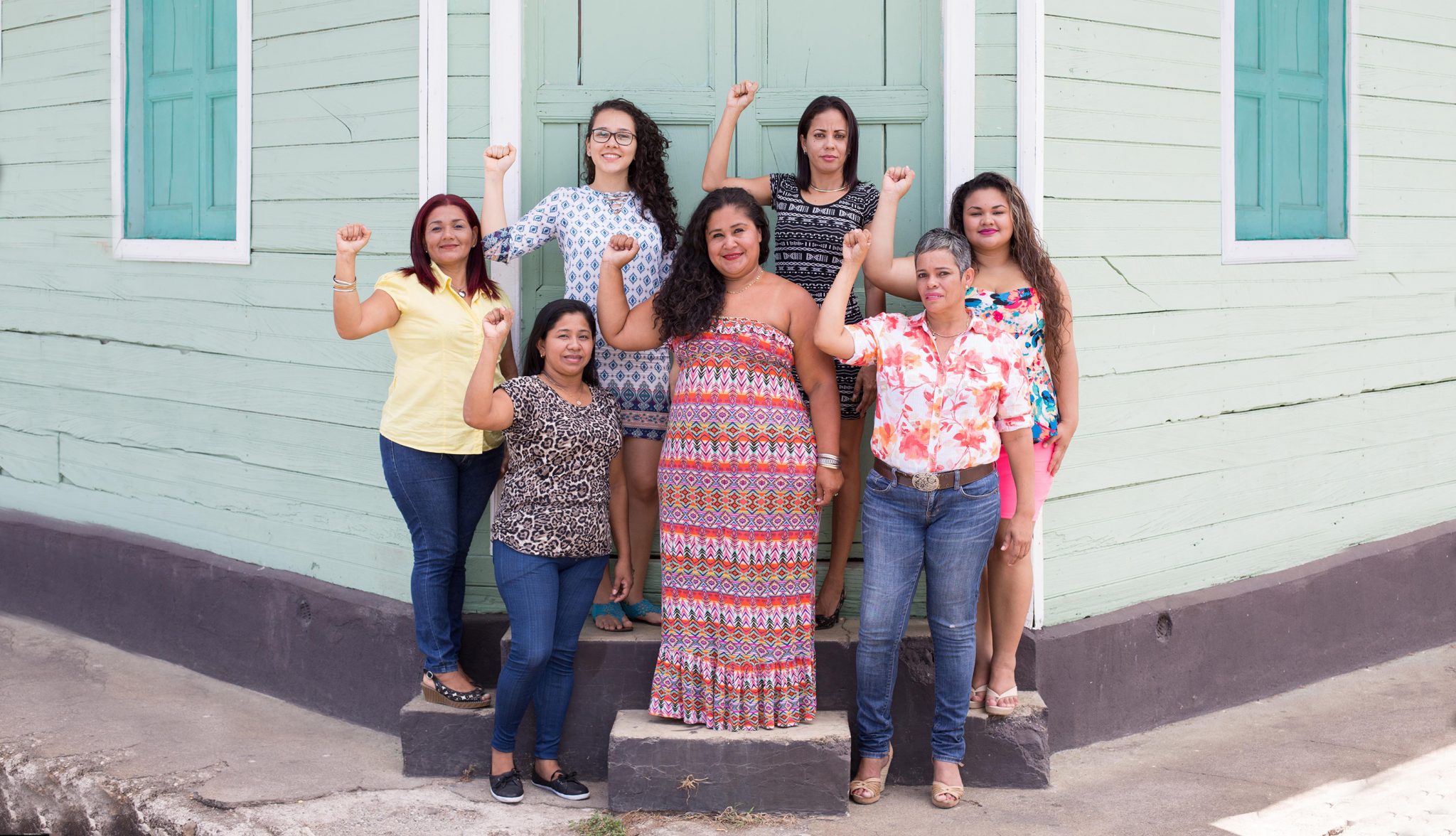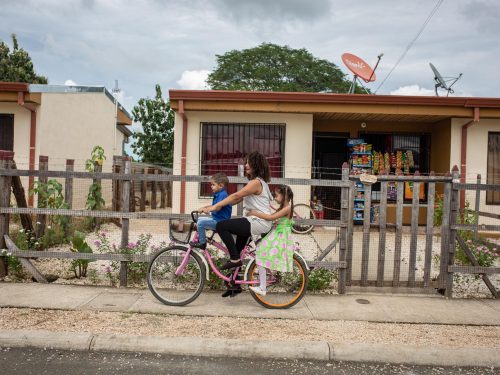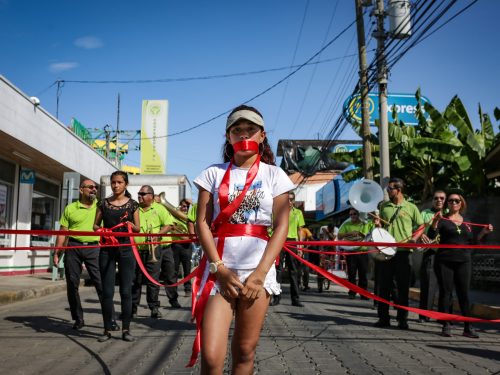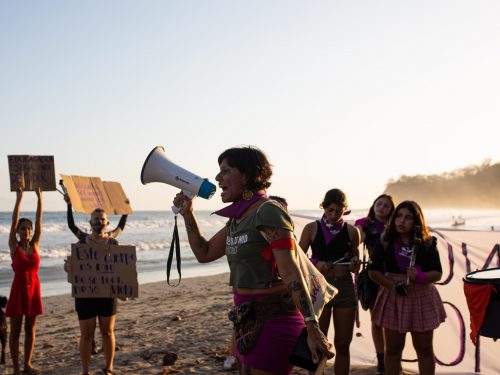
The official version that husbands from Brasilito were always told was that Rosario Chayo Gutiérrez gave craft workshops to their wives so that they could make extra money and contribute something to the household. Secretly, Chayo had another plan.
“There, I would take advantage of the moment and talk to them.” She would talk to them about things that no one had spoken to them about before, about human rights, to not let yourself be abused, that screaming is also violence. “Many women had to die so that we could have rights,” she would tell them.
The husbands found out because their wives would come home in rebellion, and they were no longer their servants or sexual slaves. They weren’t “theirs.” “I am mine,” Chayo would constantly repeat to them. They didn’t belong to their husbands.
Now I’m a business owner and I make my own clothes to sell.
Saying that the task of this Chorotega woman of Limon blood isn’t easy is stating the obvious. “You turned my woman into a devil,” one of them said to her in a threatening tone. That’s why Chayo was always careful, developing a strategy for becoming a leader in a community different than hers. “You have to introduce yourself little by little, and really take in the whole vibe of the community. I took the time to explain to them, ‘don’t you like that she makes the house nice with all the crafts?’ And they would see that it was true and start to respect me.”
Chayo knows that combating violence isn’t ‘’attacking men” but including them in the discussion. For the good of the province, she is one of those figures that, without making a lot of noise but in well-adjusted way, decided to paint a different future for Guanacaste, one in which it is no longer the region in the country that most disrespects the rights of women.
We haven’t considered the differentiated needs of each province. That´s a weakness and should be considered a failure of the state”. Larissa Arroyo, lawyer
Right now, Guanacaste is the province with the highest rates in Costa Rica of criminal complaints for domestic violence and violence against women for the third consecutive year since 2015.
Look at the numbers: Guanacaste courts receive 19 criminal complaints for every 1,000 people that live in Guanacaste in 2017 under the Violence Against Women Penal Law. The province is followed by Limon, with 17, but the average across the country is only 12 per 1,000, according to an analysis by The Voice of Guanacaste based on data from the Judicial Branch Gender Observatory (If you want to dive deeper into the data, read the secondary story).
I feel strong, empowered, and I repeat to myself that women can do anything we set our minds to.
The head of Inamu’s (Costa Rica’s national institute for women) gender violence department Ana Hidalgo says that the increasing number of cases could have two causes. One hypothesis is that women are suffering more violence. The other is that they have more information available to them in order to go to the courts. Both could be happening at the same time.
For example, “on one hand we have this harsher violence in Guanacaste and on the other hand a population of women that are learning more and more about their rights and elements to determine that what is happening to them is something they can’t accept,” said Hidalgo, who works in the Inamu central offices and supervises the programs in order to attend and prevent violence.
These explanations should be taken with a grain of salt, because they haven’t been studied sufficiently, says Dixie Mendoza, coordinator of the Judicial Branch Gender Observatory, an office created two years ago to oversee the equality processes in the judiciary.
For those who live close to this problem, the same women survivors of violence and the professionals that attend to them, the explanations aren’t clear either, but they all agree on one thing: it’s better for the number of complaints to increase than the number of femicides.
I tell women all the time not to keep quiet, that fear is overcome by talking.
Even with the increasing number of complaints, all insist that the information distributed among women in Guanacaste to defend our rights is too little and it’s not designed for women.
Nicoyan psychologist Gabriela Campos explains it this way: “”A woman in Guanacaste says, ‘I want to fix the situation with my partner,’ referring to the denial to accept that she is being abused by her partner, while in San Jose women say ‘I am being abused.’’
The Ultimate Enabler: Us
State resources to reduce violence against women are more than insufficient.
If that phrase sounds old and repetitive to you, that’s because it is. We see it in responses from authorities figures every time we ask them why a tragedy happened or why a problem wasn’t attended to on time. That’s why volunteers like Chayo Chaves seem to propose a more realistic possibility than simply thinking that Inamu should “solve everything.”
Staffed with a psychologist, a lawyer and a director, the Inamu office for Guanacaste provides training for 1,800 women per year just in the province alone. Melida Carballo, the director, thinks that at least 60% of them have suffered from violence or have had a violent episode in their lives. “When we get into the topic, revelations start to come out.”.
During a several hour session in her offices, Melida made it clear to us that there are so many cases, that the team is overwhelmed. “I have questioned when they (Inamu) do campaigns and say that you can go to the regional headquarters, because a lot of people come to our offices. It unnerves me because the installed capacity that we have is very small.”
Immediately, the group that is doing the interviewing raises the question: if there are no resources, like always, then how can we make men stop killing women?
Melida and Patricia, the psychologists, give several ideas and, above all, projects that are underway. In 1996, inter-institutional networks were set up by law to attend to violence. That network includes the police, the ebais health clinics, hospitals, the Social Aid Institute, the National Infancy Board and some 18 other institutions. But they don’t always work well, especially in zones where there is not much awareness of the issues, such as in rural areas.
“We haven’t considered the different needs of each province. That’s one of the weaknesses and it should be considered a failure of the State,” said Larissa Arroyo, a lawyer and one of Costa Rica’s staunch defenders of human rights.
911, courts, Inamu and offices on womens’ matters are some of the allies for those who suffer aggression and for their loved ones.
Ana Hidalgo, who is in charge of attending to violence issues at Inamu, explained that the institute’s commitment for the next few years is measuring the efficiency of these inter-institutional networks and confirming that they are working for the effective attention of women.
Another program is one that promotes rights, training people to support others who can, in turn, support others.
It’s an effort that involves all of us, men and women alike. The trainings are also given to men through an institute called Wëm, which works on forming non-violent men. Last year they had two workshops for Guanacastecan men in Cañas and La Cruz.
Chayo is part of those volunteers. She started receiving trainings at INA, Inamu, PANI and now she is the one leading them. Melida joins Chayo and her impetuous spirit, as well as Patricia, Jenny, Grin, Aracelly, Olga, Gabriela, Xinia, Patri, Emma, Jhonny, Sebastián, Isela, Tania and other men and women that appear in this special edition with their names and surnames and who show their faces in an effort to fight the stigma of a “machista province.” It’s a revolution that fights violence without violence.








Comments